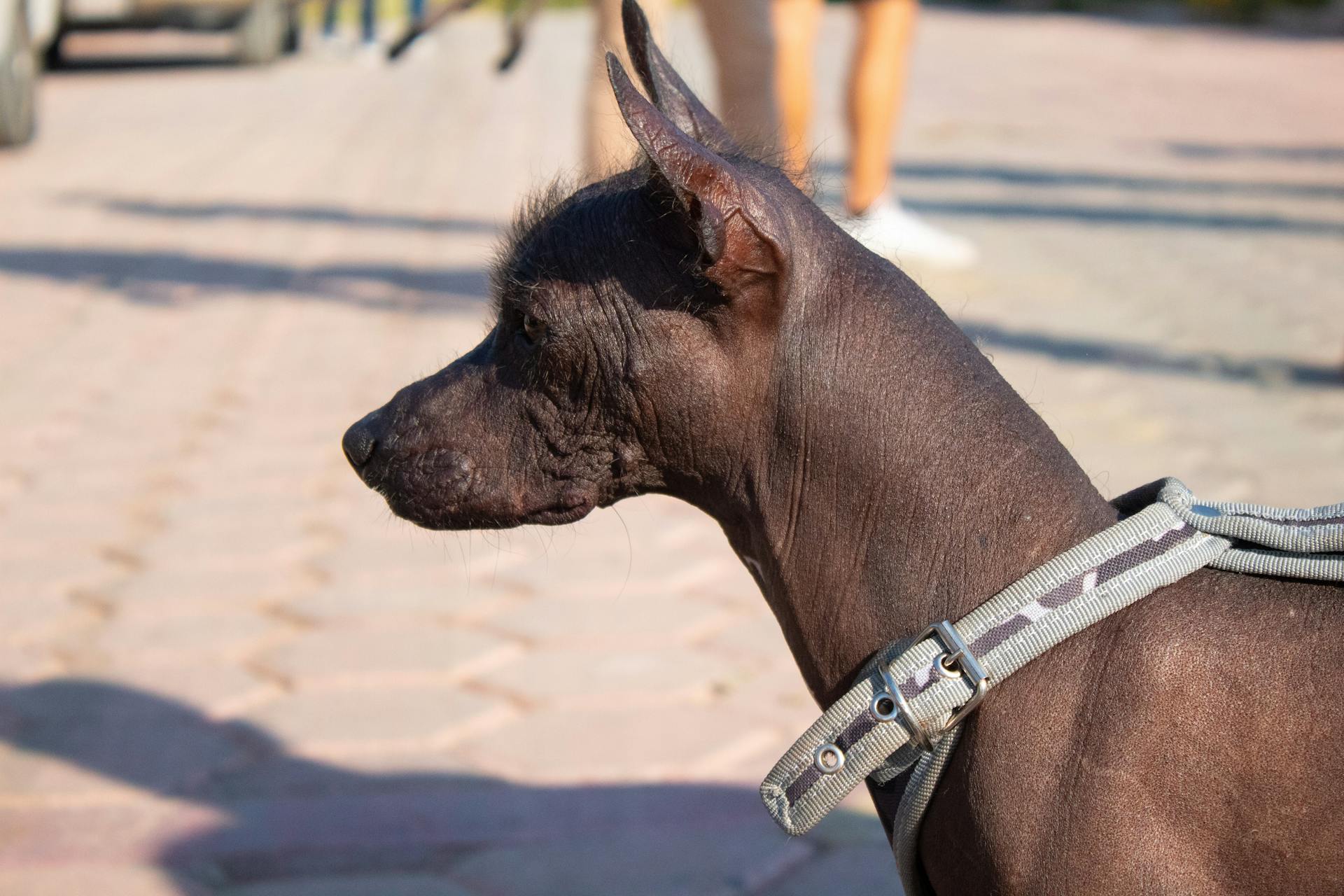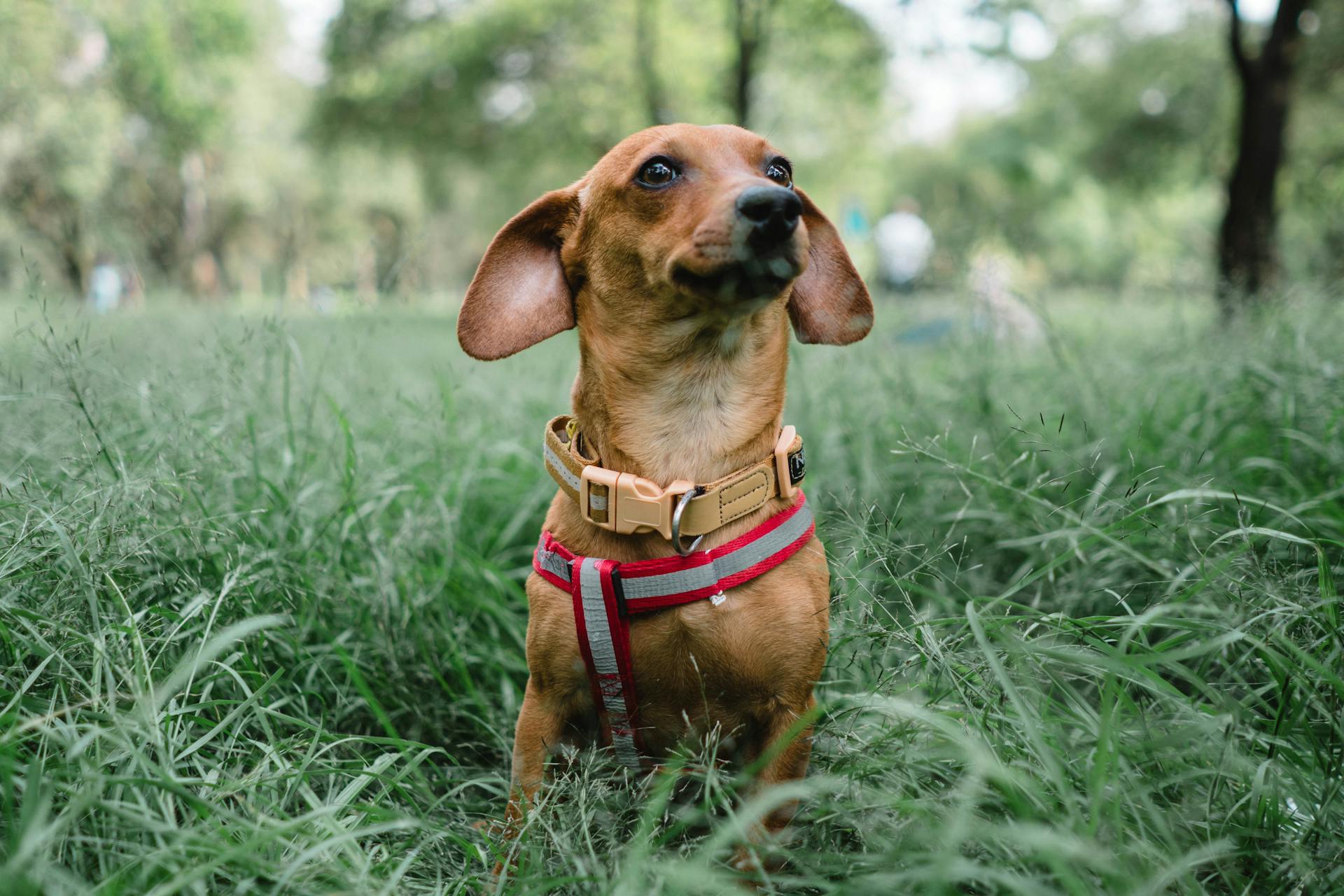
Overstimulated dog aggression is a common issue many dog owners face. According to research, over 80% of dogs exhibit some form of aggression when overstimulated.
Dogs are highly sensitive to their environment and can easily become overwhelmed. This can lead to a range of behaviors, from growling and snapping to full-blown attacks.
One key factor contributing to overstimulation is a lack of early socialization. If puppies don't receive adequate socialization, they may grow into anxious and aggressive adults.
By understanding the root causes of overstimulated dog aggression, we can take steps to address it and create a more harmonious home environment for both dogs and their owners.
Understanding Dog Aggression
Dog aggression is a serious issue that can be tricky to identify. It's often mistaken for reactivity, but the key difference is that aggressive dogs are determined to cause harm and destruction.
A dog displaying aggressive behavior may show signs like snarling, lifting their lip, or stiffening their body. These behaviors are often a communication of fear or anxiety, and if pushed, they may bite. This is a critical moment to recognize the difference between reactivity and aggression.
In many cases, fear is involved in aggressive dogs. If they lift their lip, growl, snap, or lean forward to bark or back up as they bark, they are putting space between themselves and what they fear. This is a sign that they feel anxious or afraid.
Aggressive dog behavior can be caused by a lack of socialization, prior bad experiences, or a lack of training. If your dog is displaying aggressive behavior, it's essential to find a positive reinforcement trainer who can teach strategies to keep your dog comfortable in triggering situations.
Some common behaviors that can lead to aggression include reactivity, fight or flight, resource guarding, and leash reactivity. Understanding these behaviors can help you identify the root cause of your dog's aggression.
Here are some signs of aggressive behavior in dogs:
- Muzzle punching or punching someone with their nose
- Snarling
- Snapping
- A bite that damages the skin
- A bite that causes a bruise
- A bite that causes puncture wounds
- Repeated bites
If you recognize any of these signs in your dog, it's crucial to seek professional help from a trainer who specializes in aggressive dog behavior.
Managing Reactive Behavior
Managing reactive behavior is crucial to prevent it from escalating into aggression. A reactive dog is often a fearful dog, and reactivity can stem from genetics, lack of socialization, a frightening experience, or insufficient training.
Reactive dogs usually have specific triggers, such as children, fast-moving objects, or vehicles. They may suddenly feel trapped by their leash and attempt to escape. If a reactive dog approaches you, give them space rather than approaching or greeting them.
Here are some common behaviors that can lead to aggression in dogs:
- Reactivity: sudden barking, lunging, and growling in response to specific triggers
- Fight or flight: fear-induced behaviors such as shaking, pacing, whining, barking, or cowering
- Resource guarding: protecting valuable resources like toys, food, or sleeping areas
- Leash reactivity: barking or lunging at things that make them anxious or fearful
To manage reactive behavior, try counter-conditioning by associating triggers with positive outcomes. Reward your dog with treats as soon as the trigger appears, and gradually increase exposure to the trigger while maintaining a safe distance. With consistent training, your dog will learn to cope with stressful situations.
Counter Conditioning
Counter conditioning is a powerful technique to help your dog feel more comfortable around triggers. It's all about associating the trigger with something positive.
By giving your dog treats as soon as the trigger appears, you can start to change their perception. This is called "Reward the dog as soon as the trigger appears", according to Houpt.
You'll want to start at a safe distance from the trigger, so your dog feels comfortable. This might mean keeping a whole soccer field between you and some kids playing, for example.
Consistency and frequency are key when it comes to training. With time, your dog will start to associate the trigger with something positive.
Toys and praise can also be used for positive reinforcement, making it a fun and engaging process for both you and your dog.
As you progress, you can start to move closer to the trigger. Enlisting the help of a friend can make this process smoother, especially if they have a calm dog.
If your dog remains quiet and focused on you, you can ask your friend to move a little closer. But if your dog starts to get stressed, it's best to ask your friend to go farther away.
Dog Reactivity
Dog reactivity is a common issue that can make walks and interactions with your furry friend a challenge. A reactive dog is one that is overactive or in a heightened state of arousal to stimuli, such as other dogs, people, or noises.
Reactivity can stem from a lack of socialization, prior bad experiences, or insufficient training, which can be genetic or learned. Reactive dogs may lunge, bark, and growl, becoming difficult to control and move out of the situation.
Some common behaviors that can be mistaken for aggression include mouthing or nipping puppies, rough play, and physical discomfort. These behaviors don't necessarily indicate aggression, but rather over-stimulation or a need for a break.
Dogs that display reactive, fearful, or guarding behaviors can quickly become aggressive, so it's essential to address these behaviors promptly. Reactivity can be triggered by specific stimuli, such as children, fast-moving objects, or vehicles, and may cause a dog to feel trapped and attempt to escape.
Here are some common triggers for reactivity:
- Reactivity: triggered by specific stimuli, such as children, fast-moving objects, or vehicles.
- Fear: the most common reason for aggressive dog behavior, often indicated by body language such as shaking, pacing, whining, barking, or cowering.
- Resource guarding: dogs protect things they deem most worthy, such as toys, food, sleeping areas, and people.
- Leash reactivity: dogs growl, bark, or lunge toward things that make them anxious or fearful.
To manage reactivity, it's essential to use positive reinforcement techniques, such as counter-conditioning. This involves associating triggers with something positive, like treats, toys, or praise. By consistently and frequently training your dog, you can help them learn to cope with stressful situations.
Consistency and patience are key when working with a reactive dog. With time and practice, you can help your dog become more confident and calm in the presence of triggers, making walks and interactions a more enjoyable experience for both of you.
On a similar theme: Will Neutering a Dog Help with Aggression
Recognizing Overstimulation
A reactive dog is one that is overactive or in a heightened state of arousal to stimuli, often due to panic, irritation, or a lack of socialization. This can manifest in constant jumping, barking, or pulling on the leash.
Some dogs are more prone to overstimulation in certain contexts, such as when they're on a leash or in crowded spaces. Others might be more reactive to specific stimuli like other dogs or men with beards.
Check this out: Dog Leash Aggression
If your dog is jumping or pulling on the leash, they might be trying to meet another dog but aren't sure how to express themselves correctly. They could also be fearful of a human or another dog and trying to frighten them off.
Signs of overstimulation include hyperactive behaviors, hiding, compulsive behaviors, engaging in rougher play than normal, and being mouthier and nippier.
Here are some common triggers that can lead to overstimulation:
- Strange people
- Other dogs
- Men with beards
- Other dogs on-leash
- Crowded or congested spaces
- Walking at night
K9 Over-Excitement/Stimulation Signs
Dogs can become over-excited or over-stimulated due to various reasons, including lack of socialization, prior bad experiences, or insufficient training.
Hyperactive behaviors are a common sign of over-stimulation in dogs.
Hiding is also a sign of over-stimulation in dogs, indicating they're overwhelmed by their surroundings.
Compulsive behaviors, such as excessive barking or pacing, can be a sign of over-stimulation in dogs.
Engaging in rougher play than normal and being mouthier and nippier are also signs of over-stimulation in dogs.
Some dogs may exhibit over-excitement due to being over-stimulated, which can be misinterpreted as aggression.
Dogs who are over-excited may redirect their excess energy towards other animals, humans, or objects, leading to negative consequences.
A dog's over-excitement can be aimed at vehicles, bikes, skateboards, or other triggers that elicit a reactive behavior.
Here are some common signs of K9 over-excitement or over-stimulation:
- Hyperactive behaviors
- Hiding
- Compulsive Behaviors
- Engaging in rougher play than normal and being mouthier and nippier
It's essential to note that ignoring over-excitement and rewarding calm behavior can help manage over-stimulation in dogs.
Dogs take their lead from their owners, so it's crucial to stay calm and composed when interacting with them.
By recognizing the signs of over-stimulation and taking steps to manage it, you can help your dog feel more relaxed and comfortable in their environment.
Worth a look: Does Cbd Help with Dog Aggression
Exercise the Dog
Your dog has been waiting all day for you to come home and play, and he's likely to be at a keen edge of arousal. This can lead to tug-the-leash games that end with your dog overstimulated and you upset.
Play with your dog in the yard before taking him for a walk to get rid of some of his energy. Throw his ball or a stick, and have him go over jumps as part of his fetch game.
If your dog is grabbing at you while you play, put yourself inside an exercise pen or behind a closed porch gate and throw toys or play with a flirt pole until he's tired.
Nose exercise is surprisingly tiring for a dog, so scatter small but tasty treats all over the yard and let him criss-cross the yard in search of treasure.
If you don't have a yard, play physical inside games such as tug, chasing toys or treats down the hall, until you've taken the edge off.
A fresh viewpoint: Normal Dog Play vs Aggression
Life in the Litter
Watching littermates play together can be a great indicator of a pup's future behavior. If one pup bites another too hard, the bitten pup will usually yelp or snarl and move away for a moment.
The pup who bit will normally readjust his play and re-engage his sibling, and play will continue. This is a good sign, as it shows the pup is learning to regulate his behavior.
However, if a pup continues to bite hard even when his littermates let him know they don't like it, he may be a shark in the making.
In this case, it's best to pick a different pup or be prepared to deal with the behavior.
Sources
- https://www.vet.cornell.edu/departments-centers-and-institutes/riney-canine-health-center/canine-health-information/managing-reactive-behavior
- https://www.whole-dog-journal.com/behavior/how-to-survive-your-dogs-arousal-biting/
- https://www.thrivingcanine.com/blog/triggers-and-underlying-causes-dog-aggression-part-5-frustration-agitation/
- https://eastvalleyk9.com/aggressive-k9-behavior-misdirected-over-excitement/
- https://www.olk9md.com/reactive-vs-aggressive/
Featured Images: pexels.com


